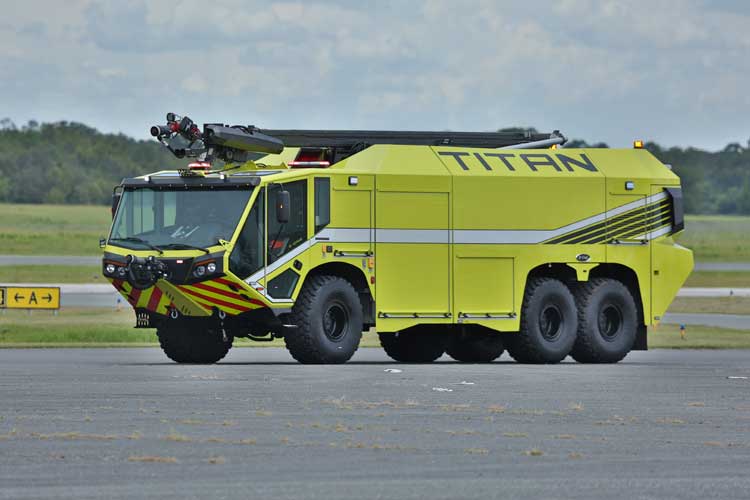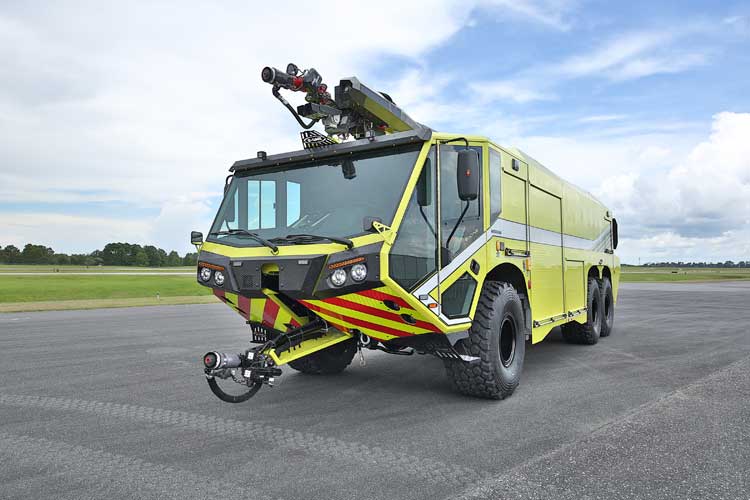A high reach extendable turret (HRET) on an aircraft rescue and firefighting (ARFF) truck offers a number of advantages to fire personnel in confronting fire situations, both on and off airport runways. These include greater accessibility to the fire, allowing different angles of attack, the ability to use a piercing nozzle, and a greater degree of safety for the crew and the vehicle.

This 65-foot High Reach Extendable Turret (HRET) is on an E-ONE Titan™ 6×6 ARFF (aircraft rescue and firefighting) truck. (Photos 1 and 2 courtesy of E-ONE.)
One of the main benefits of having an HRET on an ARFF truck is the ability to get a large master stream elevated into the air above a fire instead of shooting the extinguishing agent from a lower position on the ARFF truck, such as from a fixed roof or bumper turret. Matt Reda, International ARFF product manager for E-ONE, points out that in some scenarios it’s much easier to drop foam agent onto a target instead of shooting up at it. “With a ground-based monitor, you are trying to lob an aspirated foam solution onto the fire, but it can get sucked up into the fire’s thermal updraft,” Reda observes. “So, it may be better to approach the fire from an elevated position. Aircraft fires are similar to tank fires where it might be engulfed in flames, which would be easier to fight from the HRET’s elevated position.”
Another advantage to using an HRET is that it allows for different angles of attack as it is extended out from the ARFF truck. Reda notes that a typical roof turret on an ARFF truck can rotate only 180 degrees. “When using a roof turret on a fire, the operator might have to reposition the vehicle to get a good angle,” Reda says. “With an HRET, the unit’s turntable typically can rotate 30 degrees on each side of the vehicle, and the monitor at the end of the HRET can rotate 180 degrees, meaning the ARFF rig’s operator is able to cover a wider angle on the fire.”

The monitor on the tip of the HRET on this E-ONE Titan 6×6 can rotate 180 degrees and flow Hydro-Chem where dry chemical agent is applied in the center of the water stream.
The use of a piercing nozzle, often found on an HRET, is another benefit. “For the most part, an HRET with a piercing nozzle gives the operator the added advantage of being able to pierce and penetrate a fuselage to apply water and foam solution inside the body of the aircraft,” Reda says. “The piercing nozzle’s tip is very sharp and has small holes in it that spray the extinguishing agent in a fan shape. Usually the best place to pierce an aircraft to get to a fire inside is above an aircraft window.”
In cargo aircraft, cargo is usually stored in the underbelly of the aircraft, so piercing nozzles have extensions on them to allow the HRET to reach down lower and pierce underneath the fuselage, Reda points out. “The end of an HRET usually carries a forward looking infrared (FLIR) camera to identify hotspots and a video camera to help properly position the piercing nozzle,” he adds. “The video camera helps the operator approach at the correct angle and not have the piercing tip bounce off the fuselage, and there also are proximity sensors at the housing of the piercing tip to help get the right angle.”
Although many ARFF trucks carry dry chemical extinguishing agent in addition to water and foam, a piercing tip is not designed to flow dry chemical agent alone. However, Reda notes, Hydro-Chem technology can be applied through an HRET nozzle where dry chemical agent is applied in the center of the water stream.
E-ONE offers HRET units in 55-foot and 65-foot lengths. E-ONE’s TITAN® 6×6 ARFF truck can take either size HRET, while its TITAN® 4×4 ARFF truck takes only the 55-foot boom. HRETs are typically mounted mid-point of ARFF vehicles, consisting of a turntable at the base, and one knuckle with an elevating cylinder on the booms. Reda points out that HRETs are limited to rotate a maximum of 30 degrees on each side of the ARFF vehicle because the rigs do not carry any outriggers.
Another benefit of an HRET is the degree of safety it provides for firefighters and the rig itself. “The wing span on some large body aircraft can be huge,” Reda says. “A fire over a wing would be difficult to approach without an HRET and the greater distance from the fire allowed by an HRET means a greater measure of safety for the crew.”
ALAN M. PETRILLO is a Tucson, Arizona-based journalist, the author of three novels and five nonfiction books, and a member of the Fire Apparatus & Emergency Equipment editorial advisory board. He served 22 years with the Verdoy (NY) Fire Department, including in the position of chief.

